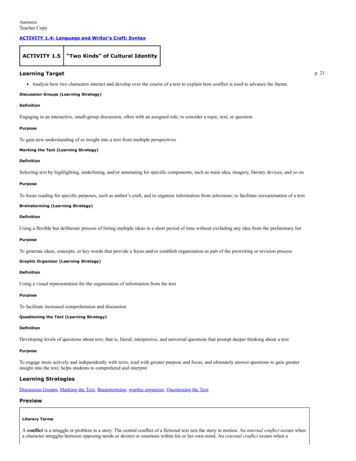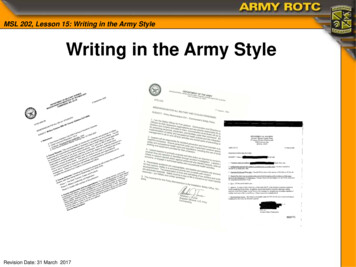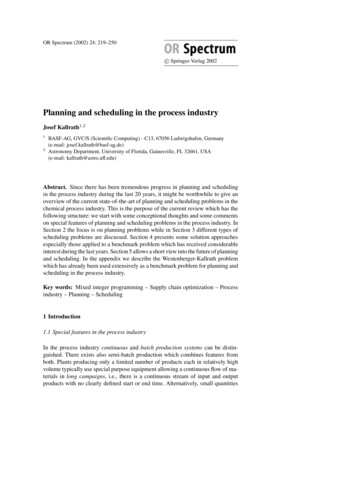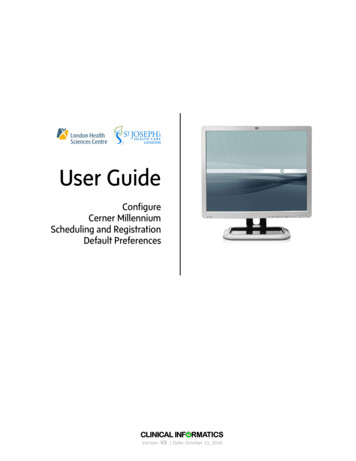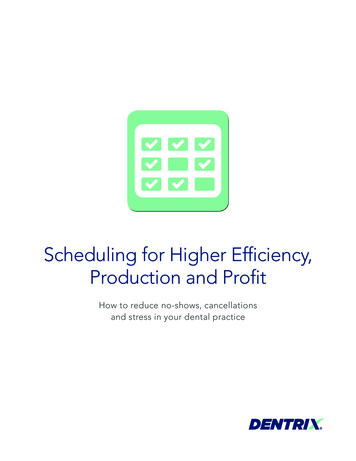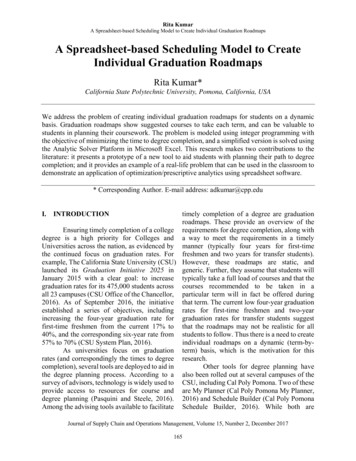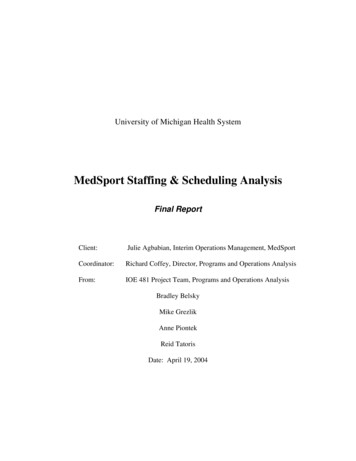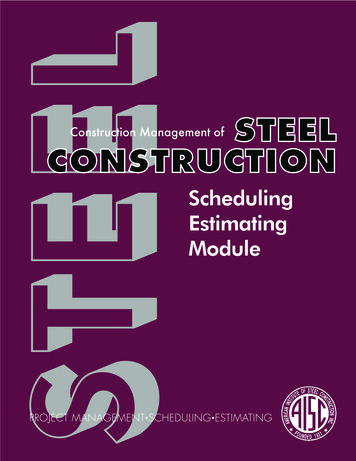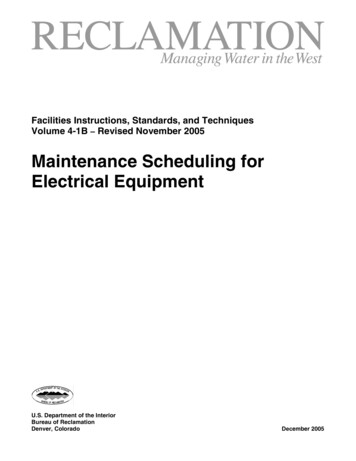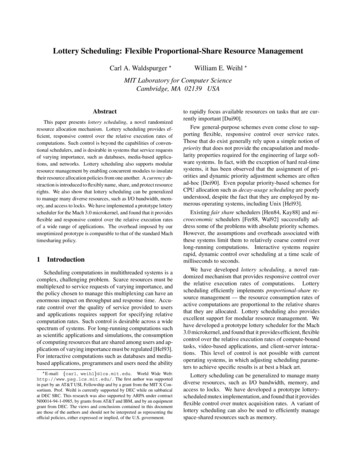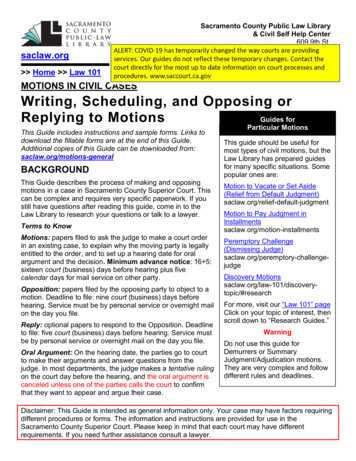
Transcription
saclaw.orgSacramento County Public Law Library& Civil Self Help Center609 9th St.Sacramento, CA 95814(916) 874-6012 Home Law 101MOTIONS IN CIVIL CASESWriting, Scheduling, and Opposing orGuides forReplying to MotionsThis Guide includes instructions and sample forms. Links todownload the fillable forms are at the end of this Guide.Additional copies of this Guide can be downloaded from:saclaw.org/motions-generalBACKGROUNDThis Guide describes the process of making and opposingmotions in a case in Sacramento County Superior Court. Thiscan be complex and requires very specific paperwork. If youstill have questions after reading this guide, come in to theLaw Library to research your questions or talk to a lawyer.Terms to KnowMotions: papers filed to ask the judge to make a court orderin an existing case, to explain why the moving party is legallyentitled to the order, and to set up a hearing date for oralargument and the decision. Minimum advance notice: 16 5:sixteen court (business) days before hearing plus fivecalendar days for mail service on other party.Opposition: papers filed by the opposing party to object to amotion. Deadline to file: nine court (business) days beforehearing. Service must be by personal service or overnight mailon the day you file.Reply: optional papers to respond to the Opposition. Deadlineto file: five court (business) days before hearing. Service mustbe by personal service or overnight mail on the day you file.Oral Argument: On the hearing date, the parties go to courtto make their arguments and answer questions from thejudge. In most departments, the judge makes a tentative rulingon the court day before the hearing, and the oral argument iscanceled unless one of the parties calls the court to confirmthat they want to appear and argue their case.Particular MotionsThis guide should be useful formost types of civil motions, but theLaw Library has prepared guidesfor many specific situations. Somepopular ones are:Motion to Vacate or Set Aside(Relief from Default Judgment)saclaw.org/relief-default-judgmentMotion to Pay Judgment tory Challenge(Dismissing y For more, visit our “Law 101” pageClick on your topic of interest, thenscroll down to “Research Guides.”WarningDo not use this guide forDemurrers or SummaryJudgment/Adjudication motions.They are very complex and followdifferent rules and deadlines.Disclaimer: This Guide is intended as general information only. Your case may have factors requiringdifferent procedures or forms. The information and instructions are provided for use in theSacramento County Superior Court. Please keep in mind that each court may have differentrequirements. If you need further assistance consult a lawyer.
saclaw.orgMotions in Civil Cases Home Law 101Tentative Ruling: at 2 p.m. on the court day before the hearing, the judge posts a preliminarydecision (“tentative ruling”) on the Sacramento Court’s website. Each party must read it and decidewhether to appear for oral argument. The oral argument is canceled unless one of the parties callsthe court to confirm between 2 p.m. and 4 p.m. on the court day before the hearing. If no call is made,the Tentative Ruling becomes the order of the court. Sacramento Local Rule (Local Rule) 1.06.Court Order: If no oral argument is held, the Tentative Ruling becomes the official court order. If oralargument is held, the court order may be issued at the end of the hearing or may be mailed out sometime later.Required Parts of Motions, Oppositions, & RepliesSince there are no pre-printed Judicial Council forms for most civil motions, you must draft themyourself. Motions must follow a very specific format.A Motion has three required parts, and an optional fourth: Notice of Motion and Motion (date, time, and location ofhearing, and a brief statement of the request);Memorandum of Points and Authorities (legal argument);Declaration(s) (evidence); andProposed Order (usually optional, but recommended.)The Notice of Motion and Motion, Memorandum of Points andAuthorities, and Declaration(s) may be filed as separatedocuments or combined together into the same document. Thetemplate and samples in this Guide combine them into one. TheProposed Order (if included) is always filed as a separatedocument. California Rule of Court (CRC) sition and Reply papers usually have two parts: Memorandum of Points and Authorities (legal argument);andDeclaration(s) (evidence), if needed.Occasionally a Motion,Opposition, or Reply willrequire additional sections,such as a Request forJudicial Notice, a SeparateStatement of UndisputedFacts, or a copy of aproposed pleading.For examples, see ourRequest for JudicialNotice form(saclaw.org/request-forjudicial-notice) and ourRelief from DefaultJudgment ns and Replies do not include a Notice of Motion and Motion or a Proposed Order. TheMemorandum of Points and Authorities and Declaration(s) may be filed as separate documents orcombined together into the same document. The template and samples in this Guide combine theminto one.Required Format: Court papers must be written on 28-line “pleading paper,” in the format requiredby CRC 2.100-2.119. The first page must display a caption containing specific information. Each linemust be numbered. Each page must have a footer with the page number and title of the document.Type style and size, margins, and line spacing are all specified. The templates accompanying thisguide satisfy these requirements.Notice of Motion and Motion: The Notice of Motion and Motion specifies the date, time, and locationwhere the hearing will take place, spells out what the party is requesting, and gives a very briefcitation to the law supporting the request. In Sacramento, the Notice of Motion and Motion must2saclaw.org/motions-general
saclaw.orgMotions in Civil Cases Home Law 101include the paragraph from Local Rule 1.06 (D) f) informing the parties of the tentative ruling system.Memorandum of Points and Authorities: The phrase “Points and Authorities” refers to legalarguments and the cases, statutes, or regulations supporting them (also called “authorities”). Theparties must explain the law and how it applies to the facts of their case. This portion of the Motion,Opposition, or Reply usually requires original research, analysis, and writing, although the LawLibrary has many resources to get you started. Particularly good starting places are listed at the endof this guide.There is a page limit of 15 pages for Motions and Oppositions, and 10 pages for Replies. These limitsdo not count declarations, exhibits, or proofs of service. (CRC 3.1113(d)). Any memorandum over 10pages must have a table of contents and table of authorities; these are not covered in this Guide.(CRC 3.1113(f)).Declaration: The parties must provide some factual basis (evidence) for their arguments. This isgenerally done by attaching a Declaration, written by someone with first-hand knowledge of the facts,explaining the facts in numbered paragraphs. The facts are usually cited by paragraph number in theMemorandum of Points and Authorities. For example, in his Declaration, defendant David Jonesmight write:13. On July 3, 2013, I purchased a 2010 Toyota Camry, VIN 2894320,from plaintiff Smith’s Used Car Lot.In the Memorandum of Points and Authorities, Jones would write:On July 3, 2013, defendant purchased a 2010 Toyota Camry, VIN2894320, from plaintiff Smith’s Used Car Lot. (Jones Decl., Para.13.)Documents, photographs, and other attachments can beused as evidence. Attach such documents to a Declarationas exhibits. In the Declaration, identify the attachmentwith language such as “On July 3, 2013, I signed a VehiclePurchase Contract. A true and correct copy of the contractis attached as Exhibit “A” to this Declaration.” Photocopythe attachment and write “Exhibit A” on the bottom of thepage. (The second exhibit is “Exhibit B,” and so on.) If theexhibit is longer than one page, number each page A-1,A-2, A-3, and so forth. Attach the exhibits to the end of theDeclaration.Important: Sacramento CountySuperior Court requires that youturn in one copy of your Motion inwhich has the Exhibits areseparated by a rigid sheet of cardstock with a lettered tab on thebottom. Exhibits for the original andthe other copies should beseparated by a blank piece ofpleading paper with their exhibitletter or number (for instance,"Exhibit A") typed or written on thebottom of the page.Note: The Law Library sells cardstock with tabs at the CirculationDesk.3saclaw.org/motions-general
saclaw.orgMotions in Civil Cases Home Law 101Note: Declarations and exhibits must meet legal requirements to be admitted in court, which are notcovered in this Guide. For information about the requirements for different types of evidence, see “AShort Course in the Rules of Evidence,” in Chapter 13 of the self-help book Win Your Lawsuit. Auseful discussion of the types of evidence that can be used to support motions and applications canbe found at 14:490-498 of California Pretrial Practice & Forms from James Publishing.Proposed Order: While usually not required, it is advisable to include a Proposed Order with mostMotions. If the order is served along with the motion, the judge can sign it immediately after making adecision. Oppositions and Replies do not need a Proposed Order.STEP-BY-STEP INSTRUCTIONSStep 1: Schedule the Hearing (Moving Party Only—Opposing Party Go to Step 2)Only the moving party completes this step. The opposing party, who learns of the hearing when themoving party serves paperwork on them, starts at Step 2. After receiving the Opposition, the movingparty may start at Step 2 to prepare a Reply.1.1 Choose the Date for the HearingIn Sacramento, the party making the motion is responsiblefor setting the date for hearing the motion. You mustschedule it far enough in the future that you can both fileand serve it on time.Filing Deadline: The motion must be filed with the court atleast sixteen court (business) days prior to the motion date(CCP § 1005). Court days are Monday through Friday,excluding court holidays. To determine whether a particularfiling date will meet this deadline, start with your desiredhearing date and count backward (CCP § 12c) sixteen courtdays. Day one is the court day prior to the hearing. Thesixteenth court day prior to the hearing is the last possibledate that the motion can be filed with the court. (Earlier is fine.)4saclaw.org/motions-generalShortcut: 35 DaysIf you choose a date at leastthirty-five days after you plan tofile the Motion, you should haveplenty of time.If you need to have the Motionheard sooner than 35 days, followthe instructions in Section 1.1 tofind the earliest date that givesyou time to file and serve thepapers.
saclaw.orgMotions in Civil Cases Home Law 101For example, suppose you wanted to have your motion heard on June 18, 2012. You would startcounting backward using June 15, 2012 as day one. Do not count weekends or court holidays (thereis one court holiday in this example, which is Memorial Day, May 28). Your sixteenth court day beforethe hearing would be May 24, 2012, which would be the latest that the motion could be filed.Service Deadline: Before you file the motion, you must have all other attorneys (or self-representedparties) served with a copy of the motion. This means that someone over the age of 18 who is not aparty in the case must either mail or personally deliver a copy of the motion and related documents tothem.If the motion is personally served, the service must be at least sixteen court days prior to the date ofthe motion, the same as the minimum filing deadline.If the motion is served by mail, five calendar days are added before the sixteen court days (more ifthey are mailed outside California). (CCP § 1005). Calendar days include weekends and holidays, butif the final day lands on a weekend or holiday, it is pushed back to the previous court day. So, if June18, 2012 was the hearing date, the sixteenth court day before would be May 24, 2012, but countingback five more calendar days results in Saturday, May 19, 2012. Because the fifth day fell on aweekend (or holiday), the deadline for service moves back to May 18, 2012, the last court day beforethe deadline. (Earlier is fine.)When choosing the date of your motion, be sure that you have left enough time for the motion to beboth served and filed in a timely fashion. Scheduling it four weeks in advance usually gives acomfortable margin.Warning! Some motions have different time requirements. Check the rules for the motion you arefiling. The Sacramento County Superior Court has prepared a “Quick Motion Checklist” noting thedeadlines for filing and service for most motions. The Checklist is available on the Court’s website rence-list.pdf.5saclaw.org/motions-general
saclaw.orgMotions in Civil Cases Home Law 1011.2 Determine the Department to Hear and the Time of the MotionIn Sacramento, most civil cases are assigned to Department 53 or Department 54 for the purpose ofhearing motions. To determine whether your motion is in Department 53 or 54: For cases filed after January 1, 2013: If your case number ends in an odd number, then yourmotions are heard in Department 53 at 2:00 p.m. If it ends in an even number, your motionsare heard in Department 54 at 9:00 a.m.For cases filed before January 1, 2013, motions are heard in the department which wasassigned when the case was filed.A few types of motions are heard in other departments: The Presiding Judge (Dept. 47) hears all motions for consolidation, severance, bifurcation,intervention, pretrial conference, coordination, change of venue, or to advance or continue trial.Case Management Program (CMP) judges (Depts. 30 and 36) hear all case-managementrelated motions in cases assigned to the Case Management Program (mostly unlimited civilcases). Motions regarding judicial arbitration, redesignation of a case, for extension of time toanswer a complaint, for relief from CMP rules, or any motion pertaining to the certificate forshort cause matters are heard in the CMP departments.If a judge has been assigned to a case for all purposes, that judge hears all motions forthe case.Motions for reconsideration, motions regarding sanctions, and motions to tax costs areheard in the department that issued the underlying order, sanctions, or cost determination.The trial judge hears motions in limine (pretrial) and all motions after trial begins.These assignments change from time to time, so check the “Quick Motion Checklist” rence-list.pdf for a current list of which departmenthears which types of motions.Step 2: Research and Write the Motion, Opposition, or ReplyMoving parties continue here. Begin here if you are preparing an Opposition or a Reply.The requirements for Replies and Oppositions are identical, so this guide covers them together.In your papers, you must explain the law, demonstrate how it applies to your case, and (inOppositions and Replies) show why the other party’s argument is wrong. This usually requiresoriginal research, analysis, and writing. At the end of this guide, you will find a list of reference bookswith good starting points for civil motion research.There are no Judicial Council forms for most civil motions, oppositions, or replies. Instead, therelevant documents must be typed on 28-line pleading paper. Customizable templates may bedownloaded from these links:6saclaw.org/motions-general
saclaw.orgMotions in Civil Cases Home Law 101 .rtfProposed tfor Opposition to Motion/Reply to positionreply.rtfAlthough this guide is printed double-sided to save paper,you must print your documents single-sided; the court willnot accept double-sided documents.At the end of this Guide are a sample Motion and a sampleOpposition, completed by the hypothetical parties “PetraPlaintiff” and “Doug Defendant.”Step 3: Make CopiesMake four (4) copies of your Motion, Opposition, or Replyand your Proposed Order, if any. Use exhibit tabs in one ofthe copies (you can purchase the tabs at the CirculationDesk in the Law Library). Staple each of the copies, butleave the original unstapled so it can easily be scanned intothe court’s file system.Information for OpposingPartiesWritten Opposition is required.Going to the hearing is notsufficient. If you do not file awritten Opposition on time, thejudge will probably grant theMotion and cancel the hearing.What if you can’t attend on thehearing date? Call the otherparty RIGHT AWAY and ask themto re-schedule. If they refuse, youcan file a motion or ex parteapplication asking the judge topostpone (“continue”) the hearing,but you must have a very goodreason, like pre-paid plane tickets.What if you agree with theMotion? Call the other party andoffer to sign a stipulation. Usuallythe Motion can then be canceled(“taken off calendar”).One of these copies is to be served on the other party’sattorney (or the other party, if they do not have an attorney).The original and the other three copies are to be filed with the court. You should get one back afterthe clerk stamps (“endorses”) it.Step 4: Have Your Documents Served on the Attorney or Self-Represented PartyYou must serve your papers on the other attorney or self-represented party in the case by specifieddeadlines. Motions: 16 court days before hearing ( 5 calendar daysFor detailed instructions,for mailing). If the mailing deadline (16 5 days) has passed,see our Step by Stepbut there are still more than 16 court days before the hearing,Guides on service:you can have it served by personal delivery. If you miss theservice deadline entirely, you will need to re-schedule your Serving Documentsmotion.by MailOppositions and Replies: serve on the day you file, using Personal Servicea form of service that will get the papers to the otherparty by end of business the next day. For example, youcan have them served via overnight delivery, messenger, or personal delivery. If the partieshave agreed in writing to accept service by fax or email, you can use those methods.7saclaw.org/motions-general
saclaw.orgMotions in Civil Cases Home Law 101Your server can use the Judicial Council form Proof of Service – Civil (POS-040), which hascheckboxes for all of these methods, or any other appropriate Proof of Service form. The form shouldbe completely filled out at this point, but not signed. Make a copy of the unsigned proof of servicebefore proceeding.The server must serve a copy of the papers, along with a copy of the unsigned proof of service form,to the opposing attorney or self-represented litigant. The unsigned proof of service form can beattached as the last page of the Motion, Opposition, or Reply.The person doing the serving then signs the Proof of Service form, and gives the signed Proof ofService to you.Make three (3) copies of the signed Proof of Service. It is not necessary to copy the instruction page.Step 5: Assemble Your Documents for FilingAssemble your packet for filing as follows. The original should be unstapled, while each copyis stapled. Motion, Opposition or Reply,including Memorandum ofMotion,ProposedProof ofPoints and Authorities andOpposition,OrderService:Declaration with exhibits:or Reply,(if any):Original 3original plus three (3) copies.Original 3with Memo ofP&A & Decl.One copy should have anyAttached:exhibits separated by tabs.Original 3 Proposed Order, if included,plus three (3) copies. Completed Proof of Serviceform: The original plus three (3
saclaw.org Home Law 101 Disclaimer: This Guide is intended as general information only. Your case
